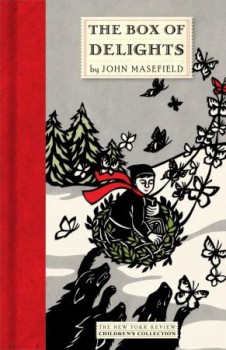A Review of John Masefield’s Christmas Book The Box of Delights

Lately I’ve become interested in what may be termed “seasonal” books — stories or novels that are perennially suited for a particular time of year. I long have considered Hope Mirrlees’s Lud-in-the-Mist a spring book. Natalie Babbit’s Tuck Everlasting is a summer book. The fall season has any number of offerings: Ray Bradbury’s Something Wicked This Way Comes, the anthology October Dreams, Washington Irving’s “The Legend of Sleepy Hollow,” and this last fall I discovered John Masefield’s The Midnight Folk.
Perhaps in due time I will look at this last in more detail, but for now I want to examine Masefield’s “Christmas Book,” The Box of Delights, something that sits well alongside Charles Dickens’s A Christmas Carol, Dr. Seuss’s How the Grinch Stole Christmas, and Clement Clarke Moore’s “A Visit from St. Nicholas.”
The Box of Delights was published in 1935 and, like The Midnight Folk, contains many delightful period terms. I choose as just one example the word “scrobble,” which means to kidnap. In this book, all sorts of people get scrobbled. The antagonist of this book, Abner Brown, who also is the antagonist of The Midnight Folk, is attempting to steal the Box of Delights from “Punch and Judy man” Cole Hawlings, who has entrusted the Box to Kay Harker, the protagonist both of this book and of The Midnight Folk. Brown scrobbles Hawlings and, unable to get any information out of that magician, scrobbles anyone who was in the vicinity of Hawlings: two of Kay’s friends and all of the clergymen and servants attached to the Tatchester Cathedral. By the end of the book, the crisis of the tale becomes in equal measure one of keeping the Box from Brown’s villainous clutches and one of returning all of the religious to the Cathedral in time to hold the Christmas services at midnight.